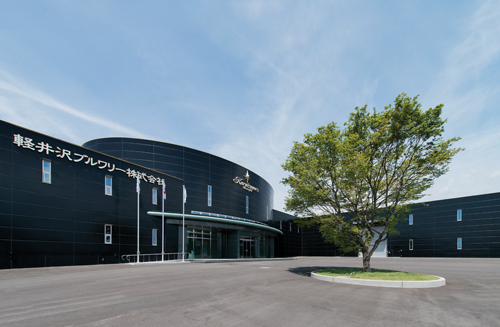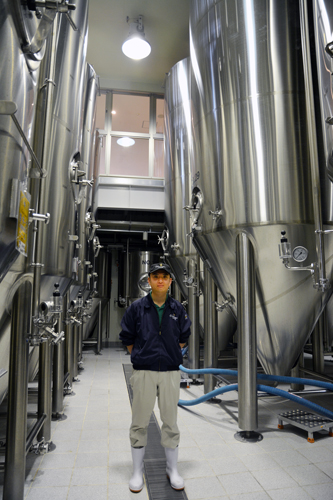by Kumagai Jinya

The beer that most people probably associate with Karuizawa, one of Japan’s finest luxury resort areas, is Yo-Ho Brewing’s Karuizawa Kogen Beer. In 2013, however, a new one emerged: Karuizawa Asama Kogen Beer, produced by Karuizawa Brewing Company in Nagano prefecture’s Saku City.
The company received its brewing license in the middle of April, 2013 and began selling its beer on June 10th. Brewery design and equipment partners BET and Laff, chosen for having shown the most interest and best ideas, broke ground for the brewery at the end of 2011 and completed construction by June of 2012. Their experience, too, was key to the decision. Thus was born a brewery with a 2000 kiloliter yearly capacity, making it one of the largest craft breweries in Japan.
Karuizawa Brewery was the vision of its parent company, Dover Ltd., which is a liquor importer and producer. After deregulation in 1994 that allowed for microbreweries, the company dreamed of launching its own but ultimately decided to focus on its core business after assessing the market. Following the construction of two new factories and years of steady growth, however, the company moved forward in 2011 with concrete plans for a craft beer division.
The head brewer since the launch, Oka Shin’ichirô, studied biotechnology in college and earned a PhD in agriculture before joining Dover Ltd.’s subsidiary, Dover Distilleries Ltd., in 2010. Thereafter, he was in charge of product development and quality control, but in the fall of 2011 transferred to the beer division. Through an introduction from BET, he then trained in Germany and later received additional instruction from Gotemba, Isekadoya and Kiuchi. That followed with more training from a veteran brewer that used to work at one of the big breweries—and who is still with him—before he proceeded with getting the brewing license.
Describing the character of Karuizawa Asama Kogen Beer in a few words, Oka says, “clean and easy to drink.” He continues, “I wanted to make a beer that is different from those of mainstream producers and yet also different from so-called ji-beers.” In short, something with premium character not captured by the Big Four. He also didn’t want to make the kind of beer that you sip through for an hour but then want to move on from because the flavor was too bold; rather, he was aiming for something more akin to a session beer.
This line of thinking also reflects in the packaging. The bottles are partially transparent and wonderfully smooth to the touch—it’s not the kind of bottle you’d dump without a thought. The brewery even has boxes for a single bottle if you’re using them as gifts. The label art for both bottles and cans is by Japanese painter Senju Hiroshi. This was no coincidence; a museum dedicated to the artist is also located in the same town as the brewery. I can’t say I know of any other instances where a Japanese painter has produced special label art for a flagship beer. The architectural design of the brewery is also unique. Located in a distribution business park, it’s modern, jet-black exterior really stands out.
There is fairly strong demand for the beers outside Nagano prefecture, actually. On the underground floor of Tokyo Station, the liquor retailer Le Collier Marunouchi offers craft beer from around the country. Every month, they post a sales ranking. In January and February, Karuizawa Asama Kogen Beer’s Weiss was first, though it had slipped to second by March (first was claimed by a limited edition beer from another company, so no surprise). From Hokkaido in the north to Kumamoto in the south, supermarkets and liquor stores also carry their beers. This owes in part to the sales efforts of Karuizawa Brewery, but its parent company Dover Ltd. played no small part in this as well.
I tried several of their beers and started with the Weiss. It was a weizen by category, but had little yeast cloudiness. Naturally, the yeast aromas were not very strong, either, and for that reason the banana-like estery aromas really came through. The body was slight, even among weizens, but certainly drinkable. Maybe it would make a good gateway craft beer for neophyte friends. The Premium Clear was indeed clear but also had a refreshing sweetness. The Alt projects fresh sweetness and aroma from the malt, and wouldn’t be out of place in Düsseldorf. Karuizawa’s spring seasonal, Ouka Ranman, exhibits wonderful malt aroma, while the hop bitterness is not overly bold—as such, it tastes much like a Bohemian pilsner.
Oka relates, “The equipment that BET and Laff put in for us is so easy to use that I feel like we could make just about any style we wanted. And I do want to try all kinds of styles, but either way, for now, I’m trying my best to maintain high quality products.” And to that end, Oka gives greatest emphasis to sanitation. Quality control at Dover Distilleries, where he worked previously, enacted high standards that treat liquor products equal to food products, and Oka has carried this same practice over. In fact, Dover Distilleries produces and sells an alcohol sanitizer called Pasteuriser 77 which is so effective as to have been adopted by Antarctic exploration teams that depend on strict sanitation controls. Naturally, company-wide consciousness of sanitation is high.
While people may do everything they can to prevent accidents, natural disasters are unavoidable. As readers may recently recall, many parts of Japan experienced blizzards this past February, and Yamagata and Nagano in particular were slammed. Conditions in Yamagata, for having gotten the worst of it, were reported relatively widely, but Nagano prefecture received little coverage and it took some time before people became aware of the damage. The Olympics were being broadcast at the time, too, which was part of the reason. A flood of inquiries issued from retailers wondering why their beer hadn’t arrived. They only understood the reasons later, once the media got around to relaying the conditions.
Saku and the Karuizawa region where the brewery is located don’t generally receive much snowfall from year to year, so they were ill prepared for the dumping. Roadways basically shut down and shipments were stopped for a week. Luckily, the employees avoided any injuries and key members were able to walk to the company. Right after the snowfall, they threw themselves into getting operations back to normal. This event was one of those reminders that beer is not just about brewing, but a variety of other steps essential to delivering it to the lips of thirsty consumers.
In April, Karuizawa Brewery began selling its kölsh-style Premium Ale and plans to make it a regular part of the line-up. As there have been so many clamoring for it since their beers went on sale, it’s unlikely they will be participating in many events. Those that want to drink it on tap should go to the brewery itself. From Sakudaira Station on the Nagano bullet-train line out of Tokyo, it only takes about six minutes by taxi. In 2015, The Hokuriku bullet train from Tokyo to Kanazawa will also run through Sakudaira, making access even better. Brewery tours run every day and cost ¥500. That also gets you two tickets, either for two take-home bottles, or a drink there plus one take-home bottle. Do consider making the trip out for some of that refreshing beer while the spring breezes are still blowing.

This article was published in Japan Beer Times # () and is among the limited content available online. Order your copy through our online shop or download the digital version from the iTunes store to access the full contents of this issue.



